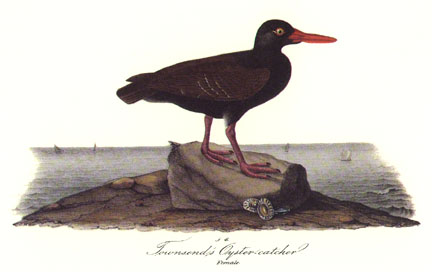

326 TOWNSEND'S OYSTER CATCHER
| A specimen of this species, which very closely resembles the last,
but is much larger, and differs in its proportions, was also forwarded
to me by Mr. TOWNSEND, but without any notice respecting its habits or
distribution. I have compared it with some specimens brought from the
coast of California, with which it agrees in all respects. It is not
improbable however, that, like our Haematopus palliatus, which in summer
extends from the shores of South America to those of Labrador, the
present species, as well as H. Bachmani, courses the shores of the
Pacific Ocean to a very high latitude. I have taken the liberty of
naming it after its discoverer.
TOWNSEND's OYSTER-CATCHER, Haematopus Townsendi, Aud. Orn. Biog., vol. v.p. 247. Female, 20; wing 11; bill 3 2/12. Coast of California, and along the shores of the North Pacific, southward and northward. Rather common. Migratory. Male. Bill long, slender but strong, slightly recurved, or ascending, beyond the nostrils, about the same height and breadth at the base, toward the end extremely compressed, terminating in an exceedingly thin wedge shaped point. Upper mandible with the dorsal line at the base straight and slightly sloping, a little arched beyond the nostrils, then nearly straight and sloping to the point, the ridge broad and flattened as far as tile prominence, afterwards extremely narrow, the sides sloping at the base, perpendicular towards the end, the edges sharp, direct, and about the middle slightly overlapping. Nasal groove basal, long; nostrils sub-basal, in the middle of the groove near the margin, linear, direct, pervious. Lower mandible with the angle rather short and narrow, the dorsal line ascending and slightly convex, the ridge very narrow, the sides erect and nearly flat, with a shallow groove at the base, the edges sharp and direct. Head of moderate size, ovate, the forehead convex. Neck rather long. Feet of moderate length, rather stout, tibia bare for three-quarters of an inch; tarsus of moderate length, somewhat compressed, covered all round with hexagonal scales; toes rather short and fleshy, the hind toe wanting, the second shorter than the fourth, the third considerably longer, all scaly at the base above, scutellate towards the end, flattened and broad beneath, with thick margins, and connected at the base by short webs, of which the outer is longer. Claws rather small, compressed, blunt, that of the middle toe largest, with a somewhat dilated thin inner edge. Plumage of the head and neck short and blended, of the back rather compact and slightly glossed, the lower parts blended, the feathers in general ovate and rounded. Wings long, acute; primaries tapering toward the end, but obtuse, the first longest, the second two-twelfths shorter, and exceeding the third by three-twelfths; secondaries broad and rounded, the inner much elongated and tapering. Tail short, nearly even, of twelve rather broad, rounded feathers, of which the lateral are scarcely shorter than the middle. Bill vermilion, paler toward the end. Edges of eyelids vermilion; iris yellow. Feet blood-red, claws dusky. The plumage is chocolate-brown, darker and tinged with bluish-grey on the head, neck, and breast; the under surface of the quills light brownish-grey, their shafts whitish. Many of the upper wing-coverts are narrowly tipped with brownish-white. Length to end of tail 20 inches; bill along the ridge 3 2/12; along the edge of lower mandible 3 4/12, its greatest height beyond the nostrils (7 1/2)/12; wing from flexure 11; tail 4 1/12; tarsus 2 5/12; inner toe (9 1/2)/12, its claw (3 3/4)/12; middle toe 1 10/12, its claw 5/12; outer toe 1 7/12, its claw (4 1/2)/12. This species is larger than the preceding, but its plumage is similar in texture and colouring. Besides its much greater size, it differs in the form of the bill, which is much longer, much deeper, more compressed, and distinctly ascending or slightly recurvate, the lower mandible especially, which in the other is quite straight. The former species also has the feet white, and the claws pale, whereas in this they seem to have been red, with the claws dusky.
|